Contents
- 1 Introduction
- 2 Assumptions, Key Features, Strengths, and Limitations of Cognitive Psychology
- 3 Cognitive Processes
- 4 Cognitive Development
- 5 Cognitive Neuroscience
- 6 Applications of Cognitive Psychology
- 7 Current Trends and Future Directions in Cognitive Psychology
- 8 Cognitive Biases: How Our Minds Can Lead Us Astray
- 9 Conclusion
- 10 References
Introduction
Cognitive psychology is the study of how mental processes such as perception, memory, and problem-solving shape our understanding of human behavior and mental functioning.
In this section we will get a deep understanding of cognitive psychology and analyze the mind and behavior.
Cognitive Psychology, a branch of psychology that focuses on understanding how the mind processes and organizes information, is a fascinating field of study that has revolutionized our understanding of human cognition.

Historical Background:
Cognitive psychology emerged as a distinct discipline in the late 1950s, challenging the prevailing behaviorist paradigm that dominated psychology at the time.
Influenced by groundbreaking research conducted by cognitive pioneers such as Jean Piaget, Ulric Neisser, and George Miller, the field gained momentum as a scientific approach to understanding the mind.
These early researchers recognized the limitations of behaviorism, which focused solely on observable behaviors, and instead aimed to uncover the underlying mental processes that shape our thoughts and actions.[1]
Learn more: History of Psychology
Cognitive Processes:
By researching into the intricate workings of our mental processes, cognitive psychology seeks to uncover the mechanisms behind perception, attention, memory, language, and problem-solving. These processes are crucial to our daily functioning and play a pivotal role in shaping our experiences and interactions with the world.
| Cognitive Function | Key Areas of Study |
| Perception The interpretation of sensory information from the environment. | Visual illusion, Depth perception and Role of attention in perception |
| Attention The ability to selectively focus on specific stimuli while ignoring others. | Attentional capacity, Selective attention and Divided attention |
| Memory The process of encoding, storing, and retrieving information. | Stages of memory (encoding, storage, retrieval)Factors influencing memory(attention, motivation, emotion) Types of memory (short-term, long-term, working memory) |
| Language The complex system of communication, including acquisition, comprehension, and expression. | Language acquisition, Language production, Language comprehension, Syntax and grammar |
| Problem-Solving and Decision-Making The cognitive processes involved in solving problems and making decisions. | Problem representation, Goal-setting, Decision-making biases and Reasoning |
Importance of Cognitive Processes in Understanding Behavior and Mental Processes
Cognitive psychology is like a guidebook to how our minds work. It helps us understand why we think, decide, and see things the way we do. It’s like uncovering the hidden gears that make our thoughts and actions happen. So, it’s all about discovering the secrets behind human behavior and thinking. For example;
- Cognitive processes are vital for understanding human behavior:
- Attention helps us allocate mental resources, determining what information we focus on and what we ignore.
- Memory research reveals how experiences are stored and retrieved, influencing our learning and recollection.
- Language comprehension and production unveil the intricacies of communication, impacting language acquisition and understanding.
- Cognitive psychology has practical applications:
- In education, it informs effective teaching methods aligned with how individuals learn and remember.
- In clinical psychology, it underpins therapies like Cognitive-Behavioral Therapy (CBT), targeting problematic thought patterns to alleviate psychological distress.
- Cognitive psychology is a scaffold for understanding the human mind:
- It uncovers internal processes shaping our perceptions, decisions, and interactions.
- It enhances scientific understanding and improves human well-being in various fields.[2]
Assumptions, Key Features, Strengths, and Limitations of Cognitive Psychology
Cognitive psychology is rooted in several fundamental assumptions and characteristics that serve as the basis for its approach to comprehending human cognition. Analyzing these underlying beliefs provides us with valuable insights into the advantages and constraints associated with this area of research.

Assumptions of Cognitive Psychology:
There are the key assumptions of cognitive psychology as concise points:
| Information Processing: | Mind functions like a complex information processor. Involves acquiring, storing, manipulating, and retrieving information, akin to a computer. |
| Mental Representations | Mind creates mental models to understand the world. These models help us perceive, understand, and interact with our surroundings. |
| Active Processing: | Cognitive processes are active and dynamic. Individuals actively process and organize incoming information. Existing knowledge guides understanding of new data. |
| Modularity: | The mind comprises modular systems for distinct cognitive functions. Modules (e.g., language processing, face recognition) operate independently and interact for complex cognition.[3] |
Key Features of Cognitive Psychology:
These are the key features of cognitive psychology:
- Experimental Methods: Cognitive psychology relies on experiments to study cognition by manipulating variables and observing responses.
- Mental Processes as Mediators: It emphasizes understanding internal processes that mediate between stimuli and responses, like encoding and retrieval.
- Quantitative Approach: Cognitive psychologists use statistics and mathematical models for precise measurement and analysis of cognitive phenomena.[4]
Strengths of Cognitive Psychology:
Followings are the main strengths of cognitive psychology:
- Scientific Rigor: Cognitive psychology’s strength lies in its rigorous, objective, and reproducible research using experimental methods and quantitative analysis.
- Ecological Validity: It strives to apply findings to real-world situations, increasing the relevance of its research beyond controlled lab settings.
- Practical Applications: Cognitive psychology’s insights have practical benefits, such as improving study techniques and informing instructional design and user interfaces.[5]
Limitations of Cognitive Psychology:
| Reductionist Perspective: | Focuses on individual cognitive components. May overlook complex interactions with external factors like culture and society. |
| Lack of Emphasis on Emotion: | Traditionally downplays the role of emotions in cognition. Needs further exploration of emotions’ impact on cognitive processes. |
| Overemphasis on Laboratory Settings: | Research primarily conducted in controlled lab environments. May not fully capture the complexity of real-world cognitive experiences.[6] |
Cognitive Processes
Cognitive psychology investigates a wide range of cognitive processes that are fundamental to human cognition. These processes, including perception, attention, memory, language, and problem-solving, shape our understanding of the world and our ability to navigate through it.
In this section, we will explore these;
- Cognitive processes in greater detail
- Examining the key theories and influential research findings that have contributed to our understanding of each process.
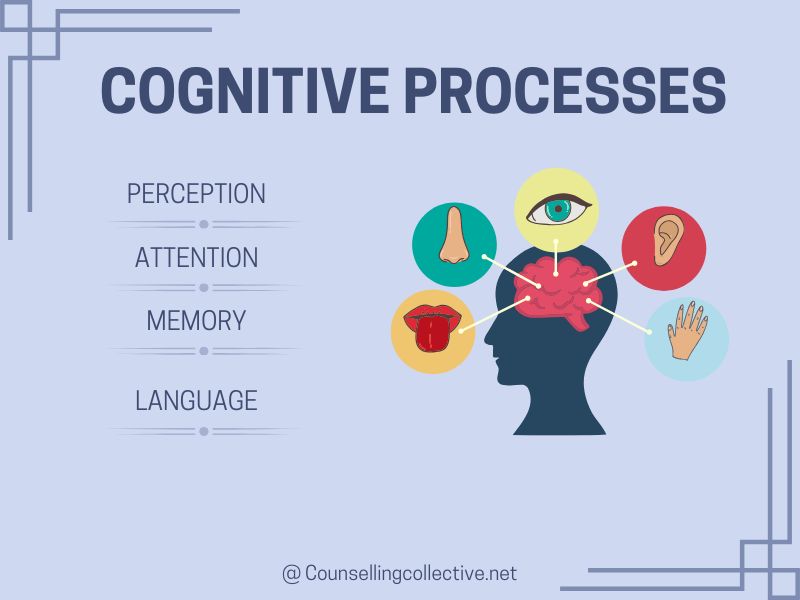
Perception:
Perception is the process by which we interpret and make sense of sensory information from our environment. Cognitive psychologists have explored various aspects of perception, shedding light on how we perceive and organize visual, auditory, and tactile motives.
One influential theory in the field is the Gestalt principles of perception, which propose that we perceive the world as organized wholes rather than isolated elements. These principles, such as the laws of proximity, similarity, and closure, provide insights into how we group and organize visual motives.
Moreover, research on visual illusions, such as the Müller-Lyer illusion or the Ponzo illusion, has revealed the role of perceptual cues and context in shaping our visual perception.
Attention:
- Attention is the cognitive process that allows us to selectively focus on certain stimuli while filtering out irrelevant information.
- Cognitive psychologists have investigated different aspects of attention, such as ; Attentional capacity, Selective attention and Divided attention
- One influential theory is the spotlight model of attention proposed by Michael Posner, which suggests that attention operates like a spotlight, selectively illuminating specific areas of our sensory input.
- Research on attention has also revealed the existence of attentional biases, such as the tendency to attend to stimuli that are emotionally salient or relevant to our goals.[7]
Memory:
Memory is a crucial cognitive function that enables us to encode, store, and retrieve information. Cognitive psychologists have extensively investigated different aspects of memory, including its stages (encoding, storage, and retrieval) and types (short-term memory, long-term memory, and working memory).
Stages of Memory:
- Encoding: Encoding is the first stage of memory processing, where information from the external world is transformed into a format that can be stored in memory. This process involves translating sensory input into a meaningful and memorable form, such as converting a visual image into a mental image or language-based code.
- Storage: Storage is the second stage of memory, where encoded information is held over time. It involves retaining the encoded data in various memory systems, such as short-term memory and long-term memory, for future retrieval. The duration and capacity of storage can vary significantly depending on the memory system involved.
- Retrieval: Retrieval is the final stage of memory processing, where stored information is recalled and brought back into conscious awareness. It involves accessing and reconstructing the stored memory traces, making them available for use in cognitive processes like recall, recognition, or problem-solving. Successful retrieval depends on the strength of encoding and the accessibility of stored memories.
Types of Memory
- Short-Term Memory: Short-term memory, also known as primary or active memory, is a temporary storage system that holds a limited amount of information for a brief period, typically for up to 20-30 seconds. It plays a crucial role in tasks like remembering a phone number long enough to dial it or retaining the beginning of a sentence while comprehending the end.
- Long-Term Memory: Long-term memory is the storage system responsible for retaining information over an extended period, potentially for a lifetime. It includes both explicit memory (facts and events we can consciously recall) and implicit memory (unconscious memory processes, like skills and habits). Long-term memory is believed to have almost unlimited capacity and is essential for learning and forming our knowledge base.
- Working Memory: Working memory is a cognitive system responsible for temporarily holding and manipulating information needed for complex cognitive tasks, such as problem-solving and comprehension.
- It acts as a mental workspace, allowing us to integrate and process information from various sources in real-time. Working memory has a limited capacity and is closely linked to our ability to focus, reason, and make decisions.
Moreover, one influential theory is the multi-store model of memory proposed by Richard Atkinson and Richard Shiffrin, which suggests that memory involves a series of distinct stores, each with its own capacity and duration.
Besides, studies on memory distortions, such as false memories or the misinformation effect, have highlighted the fallibility of memory and the influence of external factors on its accuracy.[8]
Language:
Language is a central aspect of human cognition, enabling us to communicate, express our thoughts, and share knowledge. Cognitive psychologists have investigated various aspects of language processing, including; Language acquisition, Production, Comprehension and Representation.
One influential theory is Noam Chomsky‘s theory of universal grammar, which proposes that humans are born with an innate language acquisition device that allows us to acquire language rapidly and effortlessly.
Research on language processing has also revealed the role of cognitive processes, such as; parsing sentences, understanding syntactic structures and Accessing the meaning of words. Additionally, studies on language development and language disorders, such as aphasia, have provided insights into the intricate mechanisms underlying language production and comprehension.
Problem-Solving and Decision-Making:
Cognitive psychology also examines the cognitive processes involved in problem-solving and decision-making. Researchers have investigated how individuals approach and solve problems, exploring the role of cognitive strategies, heuristics, and reasoning.
One influential theory is the problem-space theory proposed by Allen Newell and Herbert Simon, which suggests that problem-solving involves searching through a problem space and generating and evaluating potential solutions.
Understanding these cognitive processes is essential in fields such as education, business, and medicine, where effective decision-making and problem-solving are crucial.[7]
Cognitive Development
Cognitive development refers to the progressive changes in cognitive abilities and processes that occur as individuals grow and mature.
This field of study, influenced by the work of Jean Piaget and Lev Vygotsky, seeks to understand how children acquire and develop their cognitive abilities, including thinking, problem-solving, and reasoning.
In this section, we will explore the key theories and stages of cognitive development, as well as the factors that influence this process.
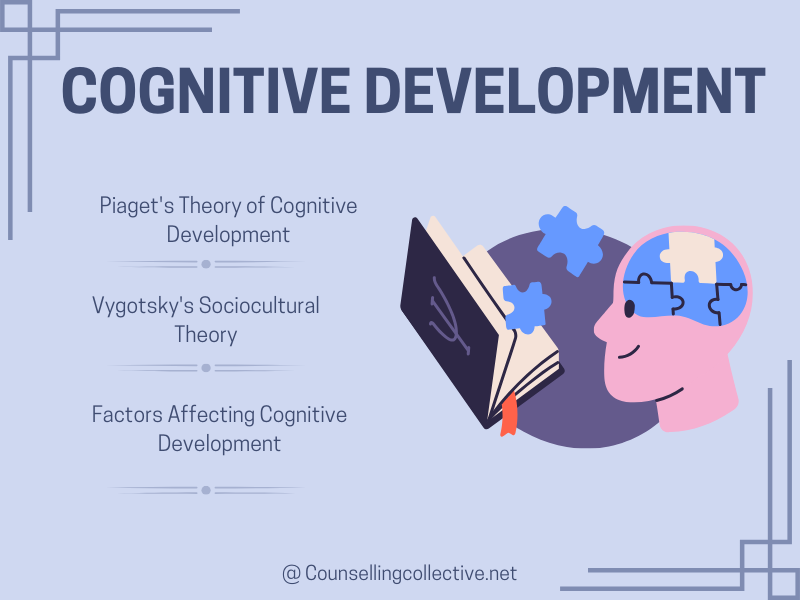
1. Piaget’s Theory of Cognitive Development:
Jean Piaget, a Swiss psychologist, proposed a comprehensive theory of cognitive development based on his observations of children. According to Piaget, cognitive development occurs in four distinct stages:
- Sensorimotor
- Preoperational
- Concrete operational
- Formal operational
Each stage is characterized by specific cognitive abilities and limitations.

Sensorimotor Stage (birth to 2 years):
During this stage, infants explore the world through their senses and actions. They develop object permanence, the understanding that objects continue to exist even when they are out of sight, and begin to demonstrate goal-directed behavior.
Preoperational Stage (2 to 7 years):
In this stage, children acquire symbolic representation, using words and mental images to represent objects and events. However, their thinking is still egocentric, and they struggle with conservation, the understanding that certain properties of objects remain the same despite changes in appearance.
Concrete Operational Stage (7 to 11 years):
Children in this stage manifest more logical and concrete thinking. They can perform operations, such as reversibility and conservation, and understand basic principles of mathematics, such as addition and subtraction.
Formal Operational Stage (11 years and beyond):
During this stage, individuals develop abstract thinking and hypothetical reasoning abilities. They can think systematically, solve complex problems, and engage in hypothetical-deductive reasoning.
Piaget’s theory has been influential in shaping our understanding of cognitive development, emphasizing the role of active exploration, assimilation, and accommodation in the construction of knowledge.[9]
2. Vygotsky’s Sociocultural Theory:
Lev Vygotsky, a Russian psychologist, proposed a sociocultural theory of cognitive development that emphasizes the role of social interaction and cultural context in shaping cognitive processes.
According to Vygotsky, cognitive development is a collaborative process that occurs through social interactions with more knowledgeable individuals, such as parents, teachers, and peers.
Vygotsky introduced the concept of the zone of proximal development (ZPD), which refers to the gap between a learner’s actual developmental level and their potential developmental level with guidance and support.
Vygotsky argued that learning occurs within the ZPD, as individuals engage in social interactions and receive scaffolding from more knowledgeable others. This scaffolding involves these elements to help learners progress to higher levels of cognitive functioning.
- Providing support
- Guidance
- Assistance
Vygotsky’s sociocultural theory highlights the importance of cultural tools, such as language and symbolic systems, in fostering cognitive development.
It also underscores the critical role of social interactions and collaborative learning environments in promoting cognitive growth.[10]
Factors Affecting Cognitive Development:
Cognitive development is influenced by a variety of factors, including biological, environmental, and socio-cultural factors.
- Biological Factors: Genetic factors play a significant role in cognitive development. For example, children inherit certain genetic predispositions that may influence their cognitive abilities, such as intelligence or language proficiency. Biological maturation, such as brain development and changes in neurotransmitter systems, also contribute to cognitive development.
- Environmental Factors: The environment in which children grow and develop has a profound impact on their cognitive abilities. Environmental factors, such as socio-economic status, access to education, and the quality of social interactions, can significantly influence cognitive development. For instance, children from disadvantaged backgrounds may face fewer opportunities for cognitive stimulation, which can impact their cognitive growth.
- Socio-cultural Factors: Cultural norms, beliefs, and practices shape cognitive development. Different cultures provide distinct learning opportunities and emphasize different cognitive skills. For example, cultures that prioritize rote memorization may foster different cognitive abilities compared to cultures that emphasize critical thinking and problem-solving.
- Educational Interventions: Effective educational interventions can enhance cognitive development. Approaches such as scaffolding, guided participation, and collaborative learning create environments that support cognitive growth. Providing opportunities for exploration, problem-solving, and critical thinking can foster higher-order cognitive abilities.[11]
Cognitive Neuroscience
Cognitive neuroscience is an interdisciplinary field that combines the study of cognitive processes with the tools and techniques of neuroscience. It seeks to understand how the brain supports various cognitive functions, such as perception, attention, memory, language, and decision-making. In this section, we will explore the contributions of cognitive neuroscience to our understanding of the neural basis of cognition and the methods used in this field of research.
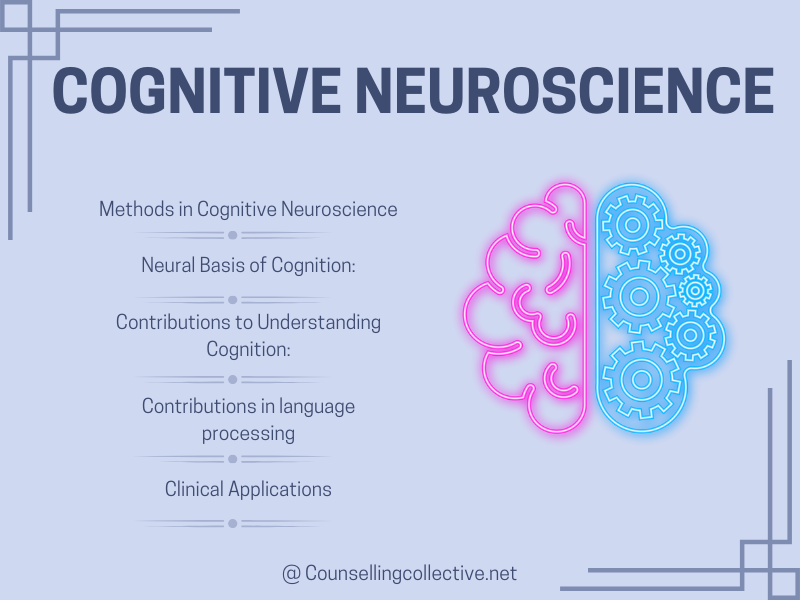
Neural Basis of Cognition:
Cognitive neuroscience investigates the neural mechanisms underlying cognitive processes. By using various imaging techniques, such as functional magnetic resonance imaging (fMRI), electroencephalography (EEG), and positron emission tomography (PET), researchers can observe brain activity while individuals engage in cognitive tasks.
These techniques allow scientists to identify the brain regions involved in specific cognitive processes.
For example, studies using fMRI have revealed that the visual cortex, located in the occipital lobe, is responsible for processing visual information. Additionally, research using EEG has provided insights into the temporal dynamics of cognitive processes, such as the event-related potential (ERP) technique, which allows researchers to measure brain activity with high temporal resolution. By examining brain activity in real-time, cognitive neuroscientists can identify the neural networks and pathways involved in different cognitive functions.
Methods in Cognitive Neuroscience:
Cognitive neuroscience employs a variety of research methods to investigate the neural basis of cognition. These methods include both invasive and non-invasive techniques, each with its advantages and limitations.
Invasive Techniques:
Invasive techniques involve directly accessing the brain to study neural activity.
Examples of invasive methods include electrocorticography (ECoG) and single-cell recording.
- ECoG involves placing electrodes directly on the surface of the brain to record electrical signals, providing detailed information about neural activity.
- Single-cell recording involves inserting microelectrodes into individual neurons to measure their firing patterns and responses.
While invasive techniques offer precise measurements of neural activity, they are limited in terms of their application to human participants due to ethical considerations.
Non-invasive Techniques:
Non-invasive techniques are widely used in cognitive neuroscience research, as they allow for the study of brain activity in humans. These methods include:
- Functional Magnetic Resonance Imaging (fMRI): It measures blood flow changes to infer neural activity and provides detailed spatial information on brain regions involved in cognition.
- Electroencephalography (EEG): EEG records electrical brain activity using scalp electrodes and examines brain waves associated with different cognitive states.
- Positron Emission Tomography (PET): PET tracks radioactive tracer distribution to measure brain metabolism and provides insights into overall brain function.
- Transcranial Magnetic Stimulation (TMS): TMS uses magnetic fields to stimulate or inhibit specific brain regions and investigates causal links between brain activity and cognitive processes.
Contributions to Understanding Cognition:
Cognitive neuroscience has made significant contributions to our understanding of cognition. By studying the neural basis of cognitive processes, researchers have gained insights into the mechanisms underlying perception, attention, memory, language, and decision-making.
- For example, research using fMRI has uncovered the neural networks involved in face recognition, revealing specialized brain regions, such as the fusiform face area (FFA).
- Studies using EEG have demonstrated the role of specific brain waves, such as alpha and theta waves, in attention and memory processes.
- PET studies have provided evidence for the involvement of dopamine in reward processing and decision-making.
- TMS studies have shown that stimulating specific brain regions can enhance or inhibit cognitive performance, further elucidating the causal relationship between brain activity and cognitive functions.
Brain Regions Associated with Language Processing Revealed by Cognitive Neuroscience
Cognitive neuroscience has mapped brain regions responsible for language comprehension and production. Broca’s area, located in the frontal lobe, is linked to language production, while Wernicke’s area, located in the temporal lobe, is involved in language comprehension. Studies using neuroimaging techniques have provided insights into the intricate neural mechanisms underlying language functions.
Clinical Applications of Cognitive Neuroscience:
The findings from cognitive neuroscience research have important clinical implications. By understanding the neural basis of cognitive processes, researchers can develop interventions and treatments for individuals with cognitive deficits or disorders.
However, cognitive neuroscience has contributed to the development of cognitive rehabilitation programs for individuals with traumatic brain injury, stroke, or neurodevelopmental disorders. These programs aim to improve cognitive functions by targeting specific brain regions or neural networks using techniques such as cognitive training, neurofeedback, or brain stimulation.
Furthermore, cognitive neuroscience research has provided insights into the neural mechanisms underlying psychiatric disorders such as schizophrenia, depression, and anxiety. By identifying abnormalities in brain activity associated with these disorders, researchers can develop more targeted and effective treatments.[12]
Applications of Cognitive Psychology
Cognitive psychology, as a field of study, has a wide range of practical applications that have had a significant impact on various aspects of human life. In this section, we will explore some of the key applications of cognitive psychology, including education, mental health, business, and technology. These applications demonstrate how the findings and principles of cognitive psychology can be utilized to improve human performance, enhance decision-making, and promote overall well-being.
This section will briefly cover the applications of cognitive psychology in the fields of education, adaptive learning system, gamification, business and decision making and Human/Machine interface.
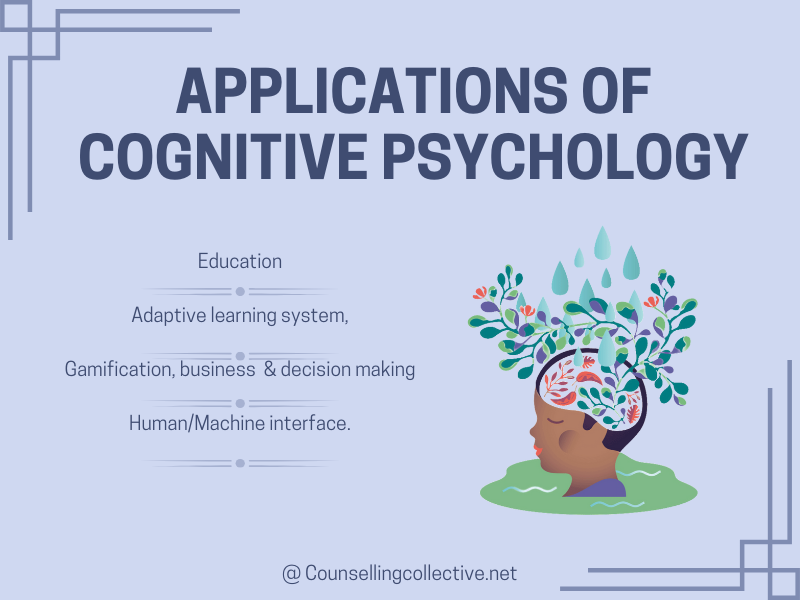
Education:
- Cognitive psychology influences education by explaining how people learn and process information.
- Understanding cognitive processes like attention, memory, and problem-solving helps design effective instructional strategies.
- Cognitive load theory guides the management of mental effort in teaching, optimizing learning outcomes.
- Scaffolding and metacognitive strategies aid learning by providing support and promoting self-awareness.
- Technology integrates cognitive insights into education, with adaptive learning, gamification, and digital mindfulness tools enhancing personalized learning experiences.
Adaptive Learning System:
- Utilizes cognitive algorithms to customize content for individual learners.
- Adjusts difficulty levels, pacing, and content based on learner performance.
- Promotes personalized and efficient learning experiences.
Gamification:
- Applies cognitive principles to game design, enhancing engagement and motivation.
- Gamified learning environments use rewards and challenges to stimulate cognitive processes and active participation.
Mental Health:
- Cognitive psychology informs the diagnosis and treatment of mental health disorders.
- Cognitive-behavioral therapy (CBT) incorporates cognitive principles to identify and change maladaptive thought patterns and behaviors.
- Effective in treating conditions like anxiety disorders, depression, and post-traumatic stress disorder.
- cognitive remediation therapy is another application of cognitive psychology in mental health. This intervention aims to improve cognitive functioning in individuals with cognitive deficits resulting from conditions such as schizophrenia or traumatic brain injury. Through targeted cognitive exercises and training, cognitive remediation therapy helps individuals enhance their attention, memory, and problem-solving skills.
Business and Decision-Making:
- Cognitive psychology offers insights into decision-making processes in the business world.
- Understanding perception, attention, and memory aids marketers in designing effective advertisements and pricing strategies.
- Organizational behavior benefits from cognitive psychology principles, enhancing training, work environments, and employee motivation.
Technology and Human-Computer Interaction:
- Cognitive psychology shapes technology and human-computer interaction.
- User-friendly interfaces and improved user experiences result from understanding how individuals interact with technology.
- Principles like Gestalt psychology inform web, software, and mobile app design.
- Cognitive psychology contributes to the development of artificial intelligence (AI) and machine learning, enabling AI systems to mimic human cognitive abilities.[13]
Current Trends and Future Directions in Cognitive Psychology
Cognitive psychology, as a field of study, is ever-evolving and continuously exploring new avenues of research.
In this section, we will discuss some of the current trends and future directions in cognitive psychology, highlighting the advancements that are shaping the field and the potential areas of exploration.
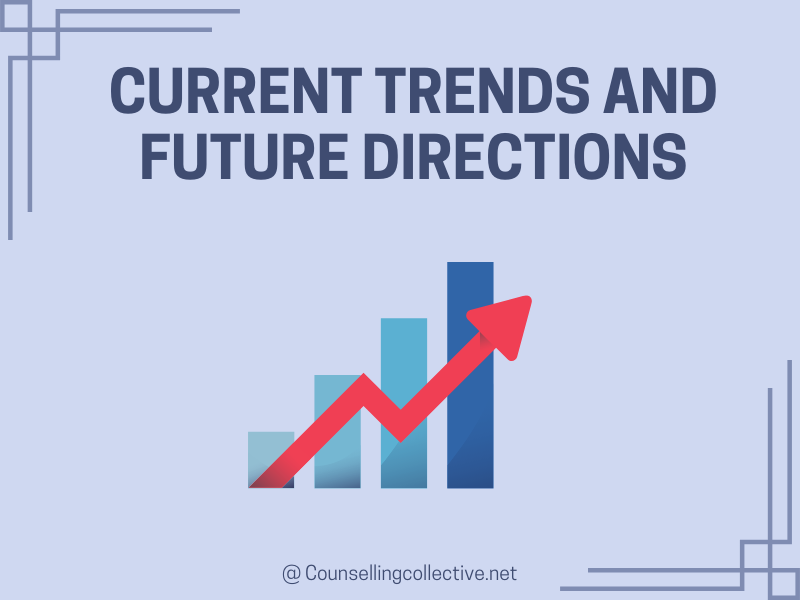
- Cognitive Neuroscience Integration This trend involves merging cognitive psychology with neuroscience to delve into the neural underpinnings of cognitive functions. It combines cognitive theories with neuroimaging techniques like fMRI and EEG to gain insights into the brain mechanisms behind cognition, with applications in understanding decision-making processes.
- Embodied Cognition This perspective highlights that cognitive processes aren’t limited to the brain alone but are influenced by the body and physical experiences. Research explores how bodily sensations and movements impact perception, emotion, and memory, leading to findings like how warmth can affect social judgments and decision-making.
- Cognitive Aging and Neuroplasticity: With an aging global population, research in this area focuses on identifying which cognitive abilities are most affected by aging and strategies to maintain cognitive health. Neuroplasticity, the brain’s adaptability, is a key concept, with interventions like cognitive training and exercise to support cognitive reserve in older adults.
- Cognitive Enhancements Researchers are exploring ways to enhance cognitive abilities through both pharmacological (e.g., cognitive-enhancing drugs) and non-pharmacological (e.g., brain stimulation and cognitive training) means. These enhancements have potential applications in education, work performance, and clinical settings.
- Artificial Intelligence and Cognitive Modeling This trend leverages advancements in AI and machine learning to create cognitive models simulating human cognitive processes. These models help test and refine cognitive theories and contribute to the development of intelligent systems that can understand and respond to human cognition, improving interactions with technology.
Cognitive Biases: How Our Minds Can Lead Us Astray
Cognitive biases are inherent flaws in our thinking processes that can cause us to make irrational judgments and decisions. These biases, which often operate unconsciously, can lead us astray by distorting our perception of reality and influencing our behavior. In this section, we will explore some common cognitive biases, discuss the concept of heuristics and biases, examine decision-making errors, and delve into the phenomenon of confirmation bias.
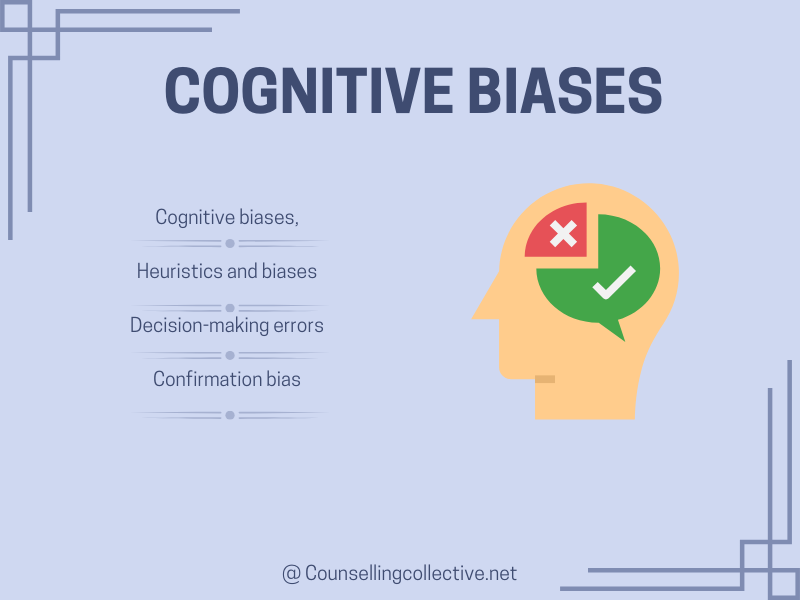
Cognitive Biases:
Cognitive biases are systematic errors in our thinking that can affect our judgment and decision-making. These biases occur due to the limitations of our cognitive processes and the shortcuts our brains take to process information efficiently. While they can sometimes be helpful in simplifying complex situations, they can also lead to faulty reasoning and inaccurate conclusions.
There are numerous cognitive biases that have been identified and studied by psychologists. Some common examples include:
- Anchoring Bias: This bias occurs when we rely too heavily on the first piece of information we encounter when making decisions, even if it is irrelevant or arbitrary.
- Availability Bias: This bias involves placing more emphasis on information that is readily available in our memory, rather than considering all relevant information. It can lead to overestimating the likelihood of events that are easily recalled.
- Confirmation Bias: Confirmation bias is the tendency to seek out information that confirms our existing beliefs or hypotheses, while ignoring or downplaying evidence that contradicts them.
- Hindsight Bias: Hindsight bias refers to the tendency to believe that an event was more predictable or inevitable after it has occurred, leading to an overestimation of one’s own ability to predict outcomes.
Heuristics and Biases
Heuristics are mental shortcuts or rules of thumb that we use to simplify decision-making processes. While heuristics can be helpful in making quick judgments, they can also lead to biases and errors.
The concept of heuristics and biases was popularized by psychologists Amos Tversky and Daniel Kahneman. They proposed that our decision-making is often influenced by cognitive biases that arise from the use of heuristics. These biases can lead us to make systematic errors and deviate from rational decision-making.
Decision-Making Errors
Cognitive biases and heuristics can contribute to various decision-making errors that can have significant consequences. These errors can occur in personal, professional, and societal contexts.
- One common decision-making error is the framing effect, which occurs when the way information is presented or framed influences our decisions. For example, people may respond differently to a medical treatment if it is described as having a 90% success rate versus a 10% failure rate, even though the information is the same.
- Understanding these decision-making errors can help us become more aware of our biases and make more rational choices in various aspects of our lives.
Confirmation Bias
Confirmation bias is a particularly pervasive cognitive bias that affects our perception of information and influences our decision-making.
- It is the tendency to seek out, interpret, and remember information that confirms our existing beliefs or hypotheses, while disregarding or downplaying information that contradicts them.
- Confirmation bias can occur in various domains, such as: Politics, religion and scientific research
- It can lead to the formation of echo chambers, where individuals only expose themselves to like-minded opinions, reinforcing their existing beliefs and preventing them from considering alternative viewpoints.
- In scientific research, confirmation bias can skew the interpretation and reporting of results. Researchers may selectively focus on findings that support their hypotheses, leading to biased conclusions and potentially hindering scientific progress.
- Overcoming confirmation bias requires conscious effort and critical thinking. It is important to actively seek out diverse perspectives, challenge our own beliefs, and consider evidence that may contradict our initial assumptions. By doing so, we can strive for more accurate and unbiased judgments.[14]
Conclusion
In this article, we’ve embarked on a journey through cognitive psychology, a field that sheds light on the intricacies of the human mind. We began by defining cognitive psychology’s significance, emphasizing how it serves as a beacon illuminating the enigmatic workings of our cognition. Our exploration has taken us through the core dimensions of cognitive psychology, encompassing perception, attention, memory, language, and problem-solving.
Exploring these areas in-depth, we’ve uncovered the cognitive mechanisms that underpin our perception of the world, revealing how our minds construct reality and make sense of it. We’ve traced the evolutionary path of cognitive development from infancy to adulthood, recognizing the profound influence of culture and society on the development of cognition. Furthermore, our journey unveiled the fascinating synergy between cognitive psychology and neuroscience, demonstrating the intricate relationship between cognitive processes and brain activity.
By continuing our journey, we explored the practical applications of cognitive psychology, witnessing its impact in educational strategies that optimize learning and clinical interventions like cognitive-behavioral therapy that enhance mental well-being.
References
- Eysenck, M. W., & Keane, M. T. (Year). Cognitive Psychology: A Student’s Handbook. Publisher. Amazon.
- Neisser, U. (2014). Cognitive Psychology: Classic Edition (1st ed.). New York. Taylor and francis group.
- Smith, E. E., & Kosslyn, S. M. (2007). Cognitive psychology: Mind and brain. In Handbook of Psychology: Vol. 4. Experimental psychology (2nd ed., pp. 273-298). Wiley. Amazon.
- Matlin, M. W. (2009). Cognition (8th ed.).Amazon
- Sternberg, R. J. (2008). Cognitive psychology. In Handbook of psychology: Vol. 1. History of psychology (2nd ed., pp. 268-285). Wiley.
- Shiffrin, R. M., & Schneider, W. (1977). Controlled and automatic human information processing: II. Perceptual learning, automatic attending, and a general theory. Psychological Review, 84(2), 127-190.
- Weiner, I. B., Reynolds, W. M., & Miller, G. E. (2012). Handbook of Psychology, Educational Psychology 2nd Edition [Kindle Edition].Amazon.
- Baddeley, A. D., & Hitch, G. J. (1974). Working Memory. In G. A. Bower (Ed.), Recent Advances in Learning and Motivation (Vol. 8, pp. 47-89). New York: Academic Press..
- Piaget, J. (1970). Piaget’s theory. In P. H. Mussen (Ed.), Carmichael’s manual of child psychology (Vol. 1, pp. 703-732). Wiley. Amazon.
- Vygotsky, L. S. (1978). Mind in society: The development of higher psychological processes. Harvard University Press. Amazon
- Zelazo, P. D. (Ed.). (2013). The Oxford Handbook of Developmental Psychology, Vol. 1: Body and Mind (Oxford Library of Psychology) 1st Edition. Amazon
- Posner, M. I., & Raichle, M. E. (1994). Images of mind. Scientific American Library .Amazon
- Neisser, U. (1976). Cognition and reality: Principles and implications of cognitive psychology. W.H. Freeman. Amazon.
- Tversky, A., & Kahneman, D. (Eds.). (1982). Judgment under uncertainty: Heuristics and biases. Cambridge University Press.
